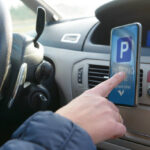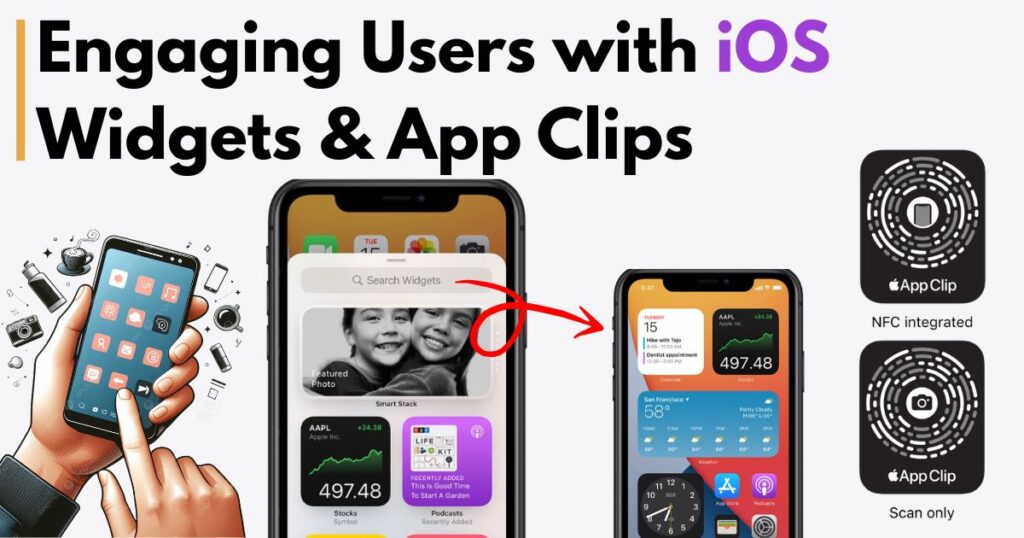In the competitive world of iOS application development, user engagement defines the long-term success of mobile apps. With each iOS release, Apple continues to focus on improving how users interact with apps. Two standout features that significantly elevate user interaction are iOS Widgets and App Clips.
According to Statista, iOS accounted for 28.8% of the global mobile operating system market in Q1 2025. Additionally, Apple reported that over 80% of active iPhone users have interacted with Widgets since iOS 17.
These figures show how Apple’s features are influencing user behavior. This article will explore the technical capabilities of Widgets and App Clips, their implementation, and how they are transforming app engagement strategies for businesses and developers.
What Are iOS Widgets?
Widgets are glanceable, resizable UI components that provide key app functionality right on the home screen or lock screen. Introduced in iOS 14 and expanded in iOS 17, widgets enable users to access content without opening the full app.
Key Characteristics:
- Real-time data updates from background processes
- Multiple sizes: small, medium, large, and extra-large (on iPad)
- Smart Stack integration for personalized display
- Interactive Widgets with button taps (from iOS 17 onwards)
How Widgets Improve Engagement:
- Offer continuous visibility for key app features
- Reduce friction for user interaction
- Keep the app top-of-mind throughout the day
Real-World Examples:
- Weather apps show real-time updates like temperature and air quality.
- Calendar apps display upcoming events and reminders.
- Fitness apps offer live activity tracking, encouraging repeated visits.
What Are App Clips?
App Clips are lightweight, mini versions of full iOS apps that users can launch instantly without downloading the complete app. Introduced in iOS 14, App Clips are ideal for quick, on-the-go interactions like food ordering, parking, or payments.
Technical Overview:
- Must be under 15MB in size
- Triggered by NFC tags, QR codes, Safari banners, or Maps
- Uses the same codebase as the main app but is deployed separately
- Supports Apple Pay, Sign in with Apple, and location services
Engagement Benefits:
- Enables users to experience app functionality without commitment
- Boosts first-time user conversion
- Reduces bounce rates caused by large app downloads
How Widgets Boost iOS Application Development Value
For businesses investing in iOS application development, widgets offer a strategic advantage. They help retain users, increase app stickiness, and drive repeat sessions.
Technical Capabilities for Developers:
- Built with SwiftUI using WidgetKit
- Background data updates via TimelineProvider
- Customizable through configuration intents
- Supports deep links to full app experiences
Use Cases in iOS App Development:
|
Industry |
Widget Use Case |
Engagement Outcome |
|
News |
Headlines + push tap to article |
Increases daily return visits |
|
Finance |
Account balance snapshot |
Promotes daily financial awareness |
|
Healthcare |
Medication reminders |
Improves compliance and user retention |
|
E-commerce |
Daily deals or shipping status |
Boosts session frequency |
How App Clips Enhance Onboarding and Conversion
When users need fast access to features without the friction of downloads, App Clips provide the ideal solution.
Developer Considerations:
- Configure App Clips in Xcode under a separate target
- Share resources with the full app for consistency
- Authenticate using Apple ID without extra login flows
- Use App Clip Experiences in App Store Connect to define triggers
Key Metrics That Improve:
- Conversion rates: First interactions often lead to full app installs
- Time-to-action: Immediate use accelerates the decision-making process
- Session duration: Designed for rapid completion of micro-tasks
Example Scenarios:
- A restaurant uses NFC tags at tables to launch an ordering App Clip
- A scooter rental company embeds QR codes on vehicles to trigger a ride-start App Clip
- A retail store adds location-based App Clips to Maps for quick browsing
User Behavior Trends Influencing Widget and App Clip Adoption
Understanding modern user expectations is crucial. With increasing demand for minimal friction and real-time information, both Widgets and App Clips align perfectly with current mobile usage trends.
Key Statistics:
- A 2024 Apple Developer report noted a 35% increase in widget-enabled app usage.
- App Clips saw a 40% higher conversion rate to full app installs than traditional App Store visits in retail apps.
Behavioral Patterns:
- Users prefer glanceable interfaces for quick updates
- Apps with low commitment entry points retain more new users
- Mobile-first interactions dominate local services and e-commerce
Best Practices for Implementing Widgets
To maximize widget utility, developers must optimize both design and performance.
Tips for Success:
- Avoid frequent background refreshes to preserve battery
- Use system fonts and colors for native consistency
- Design for all sizes to support dynamic placement
- Test in light and dark modes for visual clarity
Common Mistakes to Avoid:
- Including too much text or too many touch targets
- Failing to provide deep links to relevant app sections
- Ignoring accessibility guidelines
Best Practices for Building App Clips
While building App Clips, simplicity and speed should guide your design and functionality.
Technical and UX Guidelines:
- Focus on one core function (e.g., pay, book, order)
- Enable Apple Pay and Sign in with Apple for frictionless use
- Keep App Clip loading time under 2 seconds
- Redirect to the full app for richer experiences post-interaction
Avoid These Pitfalls:
- Overloading the App Clip with multiple screens or actions
- Using non-performant assets that increase size
- Requiring unnecessary user permissions upfront
Integration Strategy: Widgets + App Clips
Combining both features creates a layered approach to user engagement.
Example Strategy:
- Widget shows today’s coffee deals from a local café.
- Tapping it opens an App Clip for one-click ordering.
- Post-order, prompt the user to download the full app for loyalty points.
This strategy works well across industries like:
- Food delivery
- Retail
- Travel
- Fitness
Future Outlook for iOS Widgets and App Clips
Apple continues to invest in seamless app interactions. In iOS 18, developers can expect even more granular permissions, richer animations in widgets, and expanded triggers for App Clips.
Emerging Trends:
- Integration with Live Activities for real-time updates
- Expansion into watchOS and visionOS
- More adaptive layouts for different screen sizes and devices
These developments make iOS Widgets and App Clips essential tools for future-ready iOS application development.
Conclusion
Widgets and App Clips have redefined the way users interact with iOS apps. They enable more intuitive, faster, and relevant experiences—without requiring deep app navigation or full downloads. For businesses and developers involved in iOS application development, these tools represent opportunities to create engaging and user-centric experiences.
By integrating both features strategically, you can increase user retention, boost daily active usage, and elevate overall app value. As Apple continues to evolve its ecosystem, adopting these technologies early ensures your app remains competitive and future-proof.
- How iOS Widgets and App Clips Improve User Engagement in iOS Application Development
- Discover how iOS Widgets and App Clips are transforming user engagement by offering faster, more intuitive app interactions. Learn their technical benefits, real-world use cases, and why they are essential for modern iOS application development.
- iOS Widgets, App Clips, iOS Application Development, User Engagement iOS, SwiftUI Widgets, App Clip Development, Mobile App UX, iOS 18 Features, iPhone App Optimization, Apple Developer Tools
Related posts:
 Boost Your Business with These App Development Companies in Kuwait
Boost Your Business with These App Development Companies in Kuwait
 How DevOps as a Service Accelerates Cloud Transformation for Modern Enterprises
How DevOps as a Service Accelerates Cloud Transformation for Modern Enterprises
 Retained vs. Contingent Search: Understanding the Value Dynamics Search Partners Brings to Each Model
Retained vs. Contingent Search: Understanding the Value Dynamics Search Partners Brings to Each Model
 Integrating MLM Software with E-Commerce Platforms: A Step-by-Step Guide
Integrating MLM Software with E-Commerce Platforms: A Step-by-Step Guide
 Integrating MLM Software with E-Commerce Platforms: A Step-by-Step Guide
Integrating MLM Software with E-Commerce Platforms: A Step-by-Step Guide
 The Wimbo Revolution: Transforming Real-World Friendships in 2025
The Wimbo Revolution: Transforming Real-World Friendships in 2025
 How AI Call Assistants Are Helping Small Businesses Capture Every Opportunity
How AI Call Assistants Are Helping Small Businesses Capture Every Opportunity
 How Hotel Parking Management Software Transforms Guest Experience and Operational Efficiency
How Hotel Parking Management Software Transforms Guest Experience and Operational Efficiency







